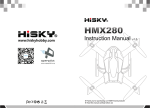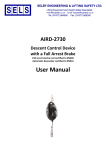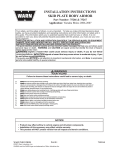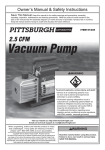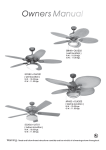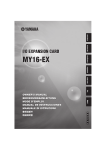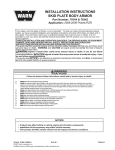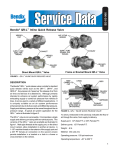Download BENDIX BW2789 User's Manual
Transcript
SD-08-203 ® Bendix® DRO Unloader Valve 4 CONTROL ATTACHES TO THE EXHAUST OF THE DRO VALVE 1 SUPPLY 21 DELIVERY 3 EXHAUST FIGURE 1 - DRO UNLOADER VALVE FIGURE 2 - SILENCER DESCRIPTION exhaust to atmosphere. Any air pressure created by the compressor during the unload operations flows out the DRO unloader valve to atmosphere. The Bendix® DRO unloader valve allows an air dryer with a turbo-cutoff valve to be used as a discharge line unloaded dryer. The DRO valve allows discharge air from the compressor to be exhausted to the atmosphere in the unloaded mode of operation. Some compressors are designed for discharge line unloading instead of head unloading. When the DRO valve is placed in the discharge line it allows both the compressor and the dryer, with turbocutoff, to function properly. The DRO valve can be used to convert a head unloaded compressor to a discharge line unloaded compressor. The exhaust (3) can be directed away from the valve using a 3/4” rubber hose. The hose should be securely fastened to the frame and should not run uphill or contain any kinks or sharp bends. An optional silencer, as shown in Figure 2, is available to reduce noise level during the unloaded operation. The silencer snaps into the bottom of the exhaust port (3). REMOVAL OPERATION (SEE FIGURE 1) 1. Disconnect the supply and delivery line fittings. The DRO unloader valve discharges air in the compressor discharge line to the atmosphere. During the charging operation of the compressor, air travels into the supply port (1) of the DRO valve. When the air brake system reaches the cut-out pressure, a pneumatic signal from the governor is sent to the control port (4) of DRO unloader valve. The pneumatic signal opens the DRO valve exhaust port (3) allowing air pressure in the compressor discharge line to 2. Remove the mounting hardware that secures the DRO unloader valve to the frame rail or mounting surface. 1 INSTALLATION The DRO valve can be installed in two configurations, series or parallel. Series Configuration The series configuration, shown in Figure 3, allows all the compressor discharge air to pass through the valve and into the dryer or reservoir. TO THE CONTROL PORT OF THE AIR DRYER GOVERNOR FROM THE RESERVOIR COMPRESSOR TO THE SUPPLY PORT OF THE AIR DRYER DRO UNLOADER VALVE Parallel Configuration The parallel configuration, shown in Figure 4, allows the DRO unloader valve to be mounted using a branch circuit. This branch circuit provides the flexibility of installing the unloader valve in a more convenient location. The branch line should not run uphill or have kinks or sharp bends that may trap condensed liquids. DRO UNLOADER VALVE TO THE SUPPLY PORT OF THE AIR DRYER TO THE CONTROL PORT OF THE AIR DRYER PORT 21 MUST BE PLUGGED FROM THE RESERVOIR FIGURE 4 - PARALLEL CONFIGURATION 1. Locate a position in the discharge line of the compressor where the DRO valve can be mounted. The valve must be mounted at the same height or below the compressor outlet. 2. Secure the DRO valve using 5/16” grade 5 or higher bolts. It is not recommended to install the valve directly on to the engine or compressor. 2 4. For a series configuration, the delivery line out of the DRO should be connected to the air brake dryer or reservoir tank. 5. For a parallel configuration, the delivery port out of the DRO must be plugged. 6. The supply and delivery ports are 22 mm metric threads. The control port is 12 mm metric threads. Consult a fitting supplier for conversion fittings. 7. Make sure there is a line from the governor unloader port to the DRO valve control port. 8. Test all connections for leaks. FIGURE 3 - SERIES CONFIGURATION GOVERNOR 3. For series installation, install a discharge line from the compressor to the DRO valve, as shown in Figure 3. For parallel installation add another discharge line into the existing compressor discharge line using a tee fitting. Connect the opposite end of this new line to the DRO unloader valve as shown in Figure 4. The valve must be at the same height or lower than the discharge line. 9. Start the engine and allow the system to reach cutout pressure. The valve should open allowing air to exit the exhaust port. A silencer, shown in Figure 2, is recommended to reduce the noise level out of the DRO valve when exhausting. Bendix provides a silencer that snaps onto the exhaust port the DRO. 10.Fan the brakes until system cut-in is reached. The DRO valve exhaust should shut allowing the air brake system pressure to increase until cut-out pressure is reached. Note: The operating range of the DRO unloader valve is from -40°F to 300°F. The DRO valve must be installed with sufficient discharge line length to prevent the air dryer inlet temperature from exceeding 160°F. To prevent failure or freeze-ups, the control air into the DRO valve must be free of liquid water and fluids and the maximum inlet pressure to the DRO valve is 174 PSI. GENERAL SAFETY GUIDELINES WARNING! PLEASE READ AND FOLLOW THESE INSTRUCTIONS TO AVOID PERSONAL INJURY OR DEATH: When working on or around a vehicle, the following general precautions should be observed at all times. 1. 2. 3. 4. Park the vehicle on a level surface, apply the parking brakes, and always block the wheels. Always wear safety glasses. Stop the engine and remove ignition key when working under or around the vehicle. When working in the engine compartment, the engine should be shut off and the ignition key should be removed. Where circumstances require that the engine be in operation, EXTREME CAUTION should be used to prevent personal injur y resulting from contact with moving, rotating, leaking, heated or electrically charged components. Do not attempt to install, remove, disassemble or assemble a component until you have read and thoroughly understand the recommended procedures. Use only the proper tools and observe all precautions pertaining to use of those tools. If the work is being performed on the vehicle’s air brake system, or any auxiliary pressurized air systems, make certain to drain the air pressure from all reservoirs before beginning ANY work on the vehicle. If the vehicle is equipped with an AD-IS ® air dryer system or a dryer reservoir module, be sure to drain the purge reservoir. 5. Fo ll ow in g t h e ve hi c l e m a nu f a c t u r e r ’s recommended procedures, deactivate the electrical system in a manner that safely removes all electrical power from the vehicle. 6. Never exceed manufacturer’s recommended pressures. 7. Never connect or disconnect a hose or line containing pressure; it may whip. Never remove a component or plug unless you are certain all system pressure has been depleted. 8. Use only genuine Bendix ® replacement parts, components and kits. Replacement hardware, tubing, hose, fittings, etc. must be of equivalent size, type and strength as original equipment and be designed specifically for such applications and systems. 9. Components with stripped threads or damaged parts should be replaced rather than repaired. Do not attempt repairs requiring machining or welding unless specifically stated and approved by the vehicle and component manufacturer. 10. Prior to returning the vehicle to service, make certain all components and systems are restored to their proper operating condition. 11. For vehicles with Automatic Traction Control (ATC), the ATC function must be disabled (ATC indicator lamp should be ON) prior to performing any vehicle maintenance where one or more wheels on a drive axle are lifted off the ground and moving. 3 4 BW2789 © 2009 Bendix Commercial Vehicle Systems LLC All rights reserved. 12/2009 Printed in U.S.A.




